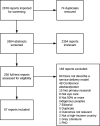Eye care delivery models to improve access to eye care for Indigenous peoples in high-income countries: a scoping review
- PMID: 33762252
- PMCID: PMC7993359
- DOI: 10.1136/bmjgh-2020-004484
Eye care delivery models to improve access to eye care for Indigenous peoples in high-income countries: a scoping review
Abstract
Purpose: Globally, there are ~370 million Indigenous peoples. Indigenous peoples typically experience worse health compared with non-Indigenous people, including higher rates of avoidable vision impairment. Much of this gap in eye health can be attributed to barriers that impede access to eye care services. We conducted a scoping review to identify and summarise service delivery models designed to improve access to eye care for Indigenous peoples in high-income countries.
Methods: Searches were conducted on MEDLINE, Embase and Global Health in January 2019 and updated in July 2020. All study designs were eligible if they described a model of eye care service delivery aimed at populations with over 50% Indigenous peoples. Two reviewers independently screened titles, abstracts and full-text articles and completed data charting. We extracted data on publication details, study context, service delivery interventions, outcomes and evaluations, engagement with Indigenous peoples and access dimensions targeted. We summarised findings descriptively following thematic analysis.
Results: We screened 2604 abstracts and 67 studies fulfilled our eligibility criteria. Studies were focused on Indigenous peoples in Australia (n=45), USA (n=11), Canada (n=7), New Zealand (n=2), Taiwan (n=1) and Greenland (n=1). The main disease focus was diabetic retinopathy (n=30, 45%), followed by 'all eye care' (n=16, 24%). Most studies focused on targeted interventions to increase availability of services. Fewer than one-third of studies reported involving Indigenous communities when designing the service. 41 studies reflected on whether the model improved access, but none undertook rigorous evaluation or quantitative assessment.
Conclusions: The geographical and clinical scope of service delivery models to improve access to eye care for Indigenous peoples in high-income countries is narrow, with most studies focused on Australia and services for diabetic retinopathy. More and better engagement with Indigenous communities is required to design and implement accessible eye care services.
Keywords: eye diseases; health systems; systematic review.
© Author(s) (or their employer(s)) 2021. Re-use permitted under CC BY. Published by BMJ.
Conflict of interest statement
Competing interests: None declared.
Figures


Similar articles
-
Eye care delivery models to improve access to eye care for Indigenous people in high-income countries: protocol for a scoping review.BMJ Open. 2019 Jul 29;9(7):e029214. doi: 10.1136/bmjopen-2019-029214. BMJ Open. 2019. PMID: 31362967 Free PMC article.
-
Economic evaluations of eye care services for Indigenous populations in high-income countries: a scoping review.Int J Equity Health. 2024 Nov 9;23(1):232. doi: 10.1186/s12939-024-02307-z. Int J Equity Health. 2024. PMID: 39516782 Free PMC article.
-
Beyond the black stump: rapid reviews of health research issues affecting regional, rural and remote Australia.Med J Aust. 2020 Dec;213 Suppl 11:S3-S32.e1. doi: 10.5694/mja2.50881. Med J Aust. 2020. PMID: 33314144
-
Characteristics of Indigenous primary health care models of service delivery: a scoping review protocol.JBI Database System Rev Implement Rep. 2015 Nov;13(11):43-51. doi: 10.11124/jbisrir-2015-2474. JBI Database System Rev Implement Rep. 2015. PMID: 26657463
-
Drivers of access to cardiovascular health care for rural Indigenous Peoples: a scoping review.Rural Remote Health. 2024 May;24(2):8674. doi: 10.22605/RRH8674. Epub 2024 May 3. Rural Remote Health. 2024. PMID: 38697785
Cited by
-
Smart Devices in Optometry: Current and Future Perspectives to Clinical Optometry.Clin Optom (Auckl). 2024 Jul 29;16:169-190. doi: 10.2147/OPTO.S447554. eCollection 2024. Clin Optom (Auckl). 2024. PMID: 39100732 Free PMC article. Review.
-
Access to Myopia Care in the United States-A Narrative Review.Invest Ophthalmol Vis Sci. 2025 Jun 5;66(7):5. doi: 10.1167/iovs.66.7.5. Invest Ophthalmol Vis Sci. 2025. PMID: 40471571 Free PMC article. Review.
-
Interventions to promote access to eyecare for non-dominant ethnic groups in high-income countries: a scoping review.BMJ Glob Health. 2021 Sep;6(9):e006188. doi: 10.1136/bmjgh-2021-006188. BMJ Glob Health. 2021. PMID: 34493531 Free PMC article.
-
Situation analysis of the social enterprises engaged in refractive error services delivery in Kenya.BMC Health Serv Res. 2025 May 5;25(1):644. doi: 10.1186/s12913-025-12831-5. BMC Health Serv Res. 2025. PMID: 40325456 Free PMC article.
-
Generating Synthetic Light-Adapted Electroretinogram Waveforms Using Artificial Intelligence to Improve Classification of Retinal Conditions in Under-Represented Populations.J Ophthalmol. 2024 Jul 16;2024:1990419. doi: 10.1155/2024/1990419. eCollection 2024. J Ophthalmol. 2024. PMID: 39045382 Free PMC article.
References
-
- UN General Assembly . United Nations Declaration on the rights of Indigenous peoples: resolution / adopted by the General Assembly, 2 October 2007, A/RES/61/295, 2007. Available: https://www.refworld.org/docid/471355a82.html [Accessed 24 Feb 2021].
-
- UN General Assembly . Transforming our world : the 2030 Agenda for Sustainable Development, 21 October 2015, A/RES/70/1, 2015. Available: https://www.refworld.org/docid/57b6e3e44.html [Accessed 24 Feb 2021].
-
- Hall G, Patrinos H. Indigenous peoples, poverty and development. New York: Cambridge University Press, 2012.
-
- United Nations Department for Economic and Social Affairs . Secretariat of the Permanent Forum on Indigenous Issues. State of the world’s indigenous peoples 2009.
Publication types
MeSH terms
Grants and funding
LinkOut - more resources
Full Text Sources
Other Literature Sources
Miscellaneous
